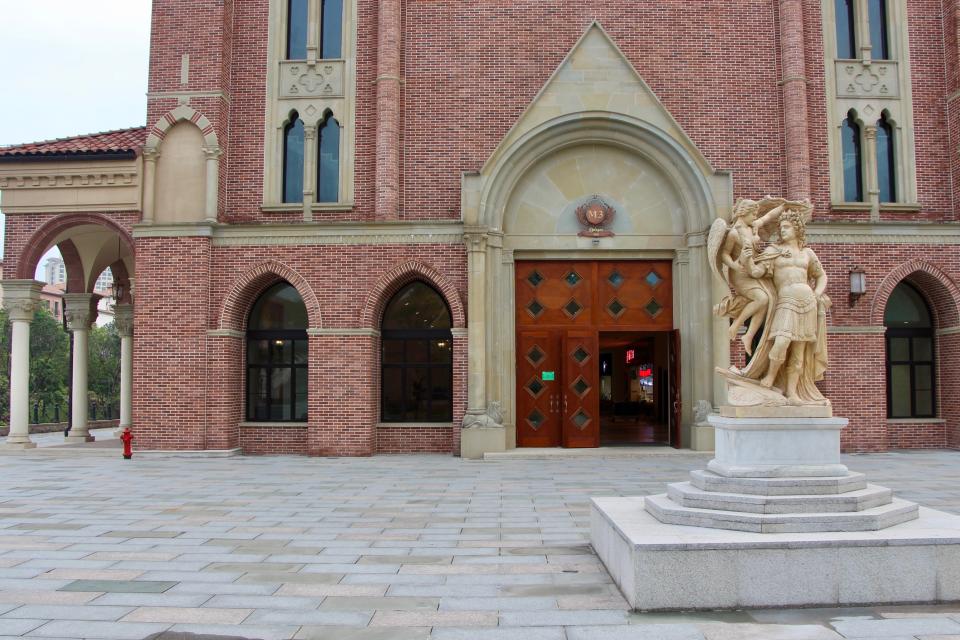Take a look inside Huawei's odd yet beautiful European-style campus
I walk off the bright orange train in Bologna, and immediately stumble upon a Roman-esque statue featuring an angel hovering beside a soldier. Behind the stone sculpture is a tall, red-brick building that looks like it may have once been a church.
Later, after a short train ride that lasts no longer than a few minutes, I find myself in Paris.
Sort of.

Despite the statues, historical-looking buildings and the signs that actually say ‘Bologna’ and ‘Paris’, I’m not in Europe. I’m in Dongguan, China, at Huawei’s sprawling campus modelled after several European cities, northwest of its equally immaculate and opulent headquarters.
In late March, I was on a tour of Huawei’s headquarters with Canadian journalists in China, something that would have been next to impossible a decade ago. The company has typically shied away from media attention and opted instead, as a book about the company says, “for silence, shunning interviews and forums and dodging awards like an ostrich hiding its head in the sand.”
Today, the telecommunications giant has changed its strategy and is trying to improve its battered reputation by going on a public relations offensive. In recent months, Huawei has opened the doors of its headquarters, inviting scores of journalists from around the world inside to take a (very structured) tour, interview executives and get a glimpse of how the company operates.

The first stop on the tour of Huawei’s headquarters is in nearby Shenzhen at the lavish executive hall, where prospective customers and executives are typically brought to be wowed, a spokesperson tells me. It is undoubtedly an impressive space. There is a massive movie-sized screen that displays the various uses of Huawei’s state-of-the-art technology (it’s not just about 5G networks and cellphones, the company says, but smart cities, data centres, railways systems, virtual reality, and more.) The floors in the hall are white marble. Hanging from the ceiling is an enormous, glittering chandelier that is wider than the screen behind it.
Where Huawei has historically favoured being humble and shy, the hall is certainly the opposite. (It’s practically screaming: ‘Look how successful we are! And how much money we have!”) The entire campus is spotless and immaculate, not a leaf seemingly out of place. Workers can be spotted outside the many buildings across the campus, cleaning up the grounds.
There are thousands of employees working at Huawei’s main headquarters, but many of those involved in research and development will be moved in coming months to the pseudo-European campus in Dongguan. Located 40-kilometres north of Shenzhen, a 50-minute drive through the city’s snarling traffic, it is practically an homage to the Western world.

Huawei calls the sprawling space, known as the Ox Horn campus, a “mini architectural marvel.” Spanning an area of 120 hectares (300 acres), the campus is divided into 12 villages, each modelled after European cities. A bright orange train imported from Switzerland shuttles employees around from station to station – or, in my case, from Bologna to Paris.
“The architects wanted to avoid the oppressive weight of a single, massive building imposed on the landscape,” a Huawei document about the campus says.
“Instead they created human spaces, in relaxed harmony with the environment around, to provide a counterpoint and release from the pressures of work. To achieve their effect, they drew deeply on centuries of architectural tradition.”
The campus is sparsely populated when we visit late in the afternoon, its various restaurants and cafes scattered across the different villages largely empty. But pretty soon, the space will be teeming with activity and home to more than 25,000 workers.
It’s here on this European-looking campus that this Chinese company will try to take its next steps into what, at this point, is an uncertain future.
Download the Yahoo Finance app, available for Apple and Android.

 Yahoo Movies
Yahoo Movies 


